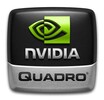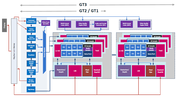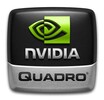NVIDIA Quadro K620M vs Intel HD Graphics 510 vs NVIDIA Quadro K4000M
NVIDIA Quadro K620M
► remove from comparison
The Nvidia Quadro K620M is a DirectX 11 and OpenGL 4.5-compatible graphics card for mobile workstations. It is a Maxwell-based GPU built on the GM108 chip with 384 shader cores and manufactured in 28 nm by TSMC. The Quadro K620M is the successor to the significantly slower Quadro K610M. Usually, the GPU comes with 2 GB DDR3 memory clocked at 1000 MHz (2000 MHz effective, 16 GB/s).
The Quadro series offers certified drivers that are optimized for stability and performance in professional applications like CAD or DCC. OpenGL performance, for example, should be significantly better than with GeForce graphics cards of similar specifications.
Architecture
Compared to Kepler, Maxwell has been optimized in several details to increase power efficiency. Smaller Streaming Multiprocessors (SMM) with only 128 ALUs (Kepler: 192) and an optimized scheduler should lead to better utilization of the shaders. Nvidia promises that a Maxwell SMM with 128 ALUs can offer 90% of the performance of a Kepler SMX with 192 ALUs. GM108 features 3 SMMs and thus 384 shader cores, 24 TMUs and 8 ROPs (64-bit interface).
Another optimization is the massively enlarged L2 cache. The larger size can reduce some of the memory traffic to allow for a relatively narrow memory interface without significantly hurting performance.
GM108 supports DirectX 11.2 (feature level 11.0 only) as well as DirectX 12.
Performance
Due to their identical specifications, the Quadro K620M offers a similar 3D gaming performance as the consumer GeForce 840M. Most games from 2014/2015 will run fluently in low or medium settings. Compared to other Quadro GPUs, the K620M performs almost similar to the older K1100M.
Features
The feature set should include support for up to 4 active displays. High-resolution monitors of up to 3840x2160 pixels can be connected using DisplayPort 1.2 or HDMI 1.4a (HDMI 2.0 not supported). HD-Audio codecs, such as Dolby TrueHD and DTS-HD, can be transmitted via bitstream mode through the HDMI port. However, as most laptops will feature Optimus, the integrated GPU will likely have direct control over the display ports and may limit the feature set available by the Nvidia Kepler cards.
Using CUDA or OpenCL, the cores of the Quadro K620M can be used for general calculations.
GM108 integrates the sixth generation of the PureVideo HD video engine (VP6), offering a better decoding performance for H.264 and MPEG-2 videos. Of course, VP6 supports all features of previous generations (4K support, PIP, video encoding via NVENC API).
Power Consumption
The power consumption of the Quadro K620M should be about 30 W including the board and memory components. Therefore, the GPU is best suited for laptops 13 - 14-inches in size and above. The K620M also supports Optimus to automatically switch between an integrated graphics card and the Nvidia GPU.
Intel HD Graphics 510
► remove from comparison
The Intel HD Graphics 510 (GT1) is an integrated graphics unit, which can be found in low-end ULV (Ultra Low Voltage) processors of the Skylake generation. This "GT1" version of the Skylake GPU offers 12 Execution Units (EUs) clocked at up to 950 MHz (depending on the CPU model). Due to its lack of dedicated graphics memory or eDRAM cache, the HD 510 has to access the main memory (2x 64bit DDR3L-1600 / DDR4-2133).
Performance
Depending on various factors like memory configuration, the HD Graphics 510 should perform sligthly below the older HD Graphics 4400 and will handle modern games (as of 2015) only in lowest settings (if it does at all).
Features
The revised video engine now decodes H.265/HEVC completely in hardware and thereby much more efficiently than before. Displays can be connected via DP 1.2 / eDP 1.3 (max. 3840 x 2160 @ 60 Hz), whereas HDMI is limited to the older version 1.4a (max. 3840 x 2160 @ 30 Hz). However, HDMI 2.0 can be added using a DisplayPort converter. Up to three displays can be controlled simultaneously.
Power Consumption
The HD Graphics 510 can be found in mobile processors specified at 15 W TDP and is therefore suited for compact laptops and ultrabooks.
NVIDIA Quadro K4000M
► remove from comparison
The NVIDIA Quadro K4000M is a high-end, DirectX 11.1 compatible graphics card for mobile workstations. It is a Kepler-based GPU built on the GK104 chip (but using only 960 shader cores) and is manufactured in 28nm at TSMC. The Quadro K4000M is built for the Intel Chief River generation (Ivy Bridge) and is the successor to the Fermi-based Quadro 4000M (Huron River platform).
The Quadro series offers certified drivers that are optimized for stability and performance in professional applications like CAD or DCC. OpenGL performance, for example, should be significantly better than GeForce graphics cards of similar specifications.
Architecture
The Kepler architecture is the successor to the Fermi architecture that first appeared in laptops with the GeForce 400M series. The GK104 Kepler core offers eight shader blocks, called SMX, that are clocked at the same speed as the central core. In the K4000M, 5 blocks are active leading to the 960 CUDA cores. Although more shader cores are available in the Kepler architecture as compared to the Fermi design, the Kepler shaders are still expected to be up to twice as power efficient. However, due to the missing hot clock of the shader domain, two shaders of a Kepler chip offer similar performance to just one shader of a Fermi chip (as the latter is clocked twice as fast).
PCIe 3.0 is now supported by the mobile Kepler series and an optional Turbo mode can automatically overclock the Nvidia card by a theoretical 15 percent if the laptop cooling system allows it. The implementation of this boost mode is done in the BIOS, but it is ultimately dependent upon the manufacturer of the laptop.
Performance
The performance is significantly above the level of the older Quadro 5010M and also beats the GeForce GTX 675M. Therefore, the card will manage both CAD software and demanding 3D games of 2013 in high quality settings.
Features
The improved feature set now includes support for up to 4 active displays. Furthermore, high resolution monitors of up to 3840x2160 pixels can now be connected using DisplayPort 1.2 or HDMI 1.4a if available. HD-Audio codecs, such as Dolby TrueHD and DTS-HD, can be transmitted via bitstream mode through the HDMI port. However, as most laptops will feature Optimus, the integrated GPU will likely have direct control over the display ports and may limit the feature set available by the Nvidia Kepler cards.
The 5th generation PureVideo HD video processor (VP5) is also integrated in the GK107 core and offers hardware decoding of HD videos. Common codecs such as MPEG-1/2, MPEG-4 ASP, H.264 and VC1/WMV9 are fully supported up to 4K resolutions while VC1 and MPEG-4 are supported up to 1080p. Two streams can be decoded in parallel for features such as Picture-in-Picture. Another novelty is the inclusion of a dedicated video encoding engine similar to Intel QuickSync that can be accessed by the NVENC API.
The power consumption of the K4000M is rated at 100 Watt (TGP according to Nvidia) and is therefore suited for large-sized notebooks 17-inches or greater.
| NVIDIA Quadro K620M | Intel HD Graphics 510 | NVIDIA Quadro K4000M | |||||||||||||||||||||||||||||||||||||||||||||||||||||||||||||||||||||||||||||||||||||||||||||||||||||||||||||||||||||||||||||||
| Quadro K Series |
|
|
| ||||||||||||||||||||||||||||||||||||||||||||||||||||||||||||||||||||||||||||||||||||||||||||||||||||||||||||||||||||||||||||||
| Architecture | Maxwell | Gen. 9 Skylake | Kepler | ||||||||||||||||||||||||||||||||||||||||||||||||||||||||||||||||||||||||||||||||||||||||||||||||||||||||||||||||||||||||||||||
| Pipelines | 384 - unified | 12 - unified | 960 - unified | ||||||||||||||||||||||||||||||||||||||||||||||||||||||||||||||||||||||||||||||||||||||||||||||||||||||||||||||||||||||||||||||
| Core Speed | 1029 - 1124 (Boost) MHz | 300 - 950 (Boost) MHz | 600 MHz | ||||||||||||||||||||||||||||||||||||||||||||||||||||||||||||||||||||||||||||||||||||||||||||||||||||||||||||||||||||||||||||||
| Memory Speed | 2000 MHz | 2800 MHz | |||||||||||||||||||||||||||||||||||||||||||||||||||||||||||||||||||||||||||||||||||||||||||||||||||||||||||||||||||||||||||||||
| Memory Bus Width | 64 Bit | 64/128 Bit | 256 Bit | ||||||||||||||||||||||||||||||||||||||||||||||||||||||||||||||||||||||||||||||||||||||||||||||||||||||||||||||||||||||||||||||
| Memory Type | DDR3 | DDR3/DDR4 | GDDR5 | ||||||||||||||||||||||||||||||||||||||||||||||||||||||||||||||||||||||||||||||||||||||||||||||||||||||||||||||||||||||||||||||
| Max. Amount of Memory | 2048 MB | 4 GB | |||||||||||||||||||||||||||||||||||||||||||||||||||||||||||||||||||||||||||||||||||||||||||||||||||||||||||||||||||||||||||||||
| Shared Memory | no | yes | no | ||||||||||||||||||||||||||||||||||||||||||||||||||||||||||||||||||||||||||||||||||||||||||||||||||||||||||||||||||||||||||||||
| API | DirectX 11, Shader 5.0, OpenGL 4.3 | DirectX 12_1, OpenGL 4.4 | DirectX 11, Shader 5.0, OpenGL 4.1 | ||||||||||||||||||||||||||||||||||||||||||||||||||||||||||||||||||||||||||||||||||||||||||||||||||||||||||||||||||||||||||||||
| Power Consumption | 30 Watt | 100 Watt | |||||||||||||||||||||||||||||||||||||||||||||||||||||||||||||||||||||||||||||||||||||||||||||||||||||||||||||||||||||||||||||||
| technology | 28 nm | 14 nm | 28 nm | ||||||||||||||||||||||||||||||||||||||||||||||||||||||||||||||||||||||||||||||||||||||||||||||||||||||||||||||||||||||||||||||
| Features | Optimus, PhysX, CUDA, OpenCL, 3D Vision, 3DTV Play | QuickSync | Optimus, PhysX, Verde Drivers, CUDA, 3D Vision, 3DTV Play | ||||||||||||||||||||||||||||||||||||||||||||||||||||||||||||||||||||||||||||||||||||||||||||||||||||||||||||||||||||||||||||||
| Date of Announcement | 01.03.2015 | 01.09.2015 | 01.06.2012 | ||||||||||||||||||||||||||||||||||||||||||||||||||||||||||||||||||||||||||||||||||||||||||||||||||||||||||||||||||||||||||||||
| Link to Manufacturer Page | www.nvidia.de | ||||||||||||||||||||||||||||||||||||||||||||||||||||||||||||||||||||||||||||||||||||||||||||||||||||||||||||||||||||||||||||||||
| Codename | Skylake GT1 | N14E-Q3 | |||||||||||||||||||||||||||||||||||||||||||||||||||||||||||||||||||||||||||||||||||||||||||||||||||||||||||||||||||||||||||||||
| Notebook Size | large |
| ||||||||||||||||||
Benchmarks
3DM Vant. Perf. total + NVIDIA Quadro K620M
specvp11 snx-01 + NVIDIA Quadro K620M
specvp12 sw-03 + NVIDIA Quadro K620M
Cinebench R15 OpenGL 64 Bit + NVIDIA Quadro K620M
GFXBench T-Rex HD Offscreen C24Z16 + Intel HD Graphics 510
Average Benchmarks NVIDIA Quadro K620M → 100% n=16
Average Benchmarks Intel HD Graphics 510 → 62% n=16
Average Benchmarks NVIDIA Quadro K4000M → 165% n=16
* Smaller numbers mean a higher performance
1 This benchmark is not used for the average calculation
Game Benchmarks
The following benchmarks stem from our benchmarks of review laptops. The performance depends on the used graphics memory, clock rate, processor, system settings, drivers, and operating systems. So the results don't have to be representative for all laptops with this GPU. For detailed information on the benchmark results, click on the fps number.

Resident Evil 7
2017
Titanfall 2
2016
Farming Simulator 17
2016
Civilization 6
2016
The Division
2016
Rainbow Six Siege
2015
World of Warships
2015
Metal Gear Solid V
2015
Dota 2 Reborn
2015
Dirt Rally
2015
Battlefield Hardline
2015
Ryse: Son of Rome
2014
GRID: Autosport
2014
Thief
2014
Battlefield 4
2013
Total War: Rome II
2013
Saints Row IV
2013
Company of Heroes 2
2013
Metro: Last Light
2013
BioShock Infinite
2013
Tomb Raider
2013
Dead Space 3
2013
Assassin´s Creed III
2012
Hitman: Absolution
2012
World of Tanks v8
2012
F1 2012
2012
Sleeping Dogs
2012
Dirt Showdown
2012
Diablo III
2012
Alan Wake
2012
Anno 2070
2011
Battlefield 3
2011
Batman: Arkham City
2011
StarCraft 2
2010Average Gaming NVIDIA Quadro K620M → 100%
Average Gaming 30-70 fps → 100%
Average Gaming Intel HD Graphics 510 → 48%
Average Gaming 30-70 fps → 45%
Average Gaming NVIDIA Quadro K4000M → 164%
Average Gaming 30-70 fps → 184%
| NVIDIA Quadro K620M | Intel HD Graphics 510 | NVIDIA Quadro K4000M | |||||||||||||||||||
|---|---|---|---|---|---|---|---|---|---|---|---|---|---|---|---|---|---|---|---|---|---|
| low | med. | high | ultra | QHD | 4K | low | med. | high | ultra | QHD | 4K | low | med. | high | ultra | QHD | 4K | ||||
| Resident Evil 7 | 18.3 | ||||||||||||||||||||
| Titanfall 2 | 19.9 | 15.4 | |||||||||||||||||||
| Farming Simulator 17 | 70.6 | 41.3 | |||||||||||||||||||
| Civilization 6 | 24.5 | 9.4 | |||||||||||||||||||
| The Division | 13.4 | 7.7 | |||||||||||||||||||
| Rise of the Tomb Raider | 11.1 | 7 | |||||||||||||||||||
| Rainbow Six Siege | 25 | 15.9 | |||||||||||||||||||
| Anno 2205 | 19.9 | 11 | |||||||||||||||||||
| World of Warships | 48.7 | 29.2 | |||||||||||||||||||
| Metal Gear Solid V | 38.9 | 25.2 | |||||||||||||||||||
| Dota 2 Reborn | 66.2 | 41.8 | |||||||||||||||||||
| Dirt Rally | 110.4 | 19.3 | |||||||||||||||||||
| GTA V | 30.9 | 26.8 | |||||||||||||||||||
| Battlefield Hardline | 31.5 | 22.2 | |||||||||||||||||||
| F1 2014 | 72 | 47 | |||||||||||||||||||
| Sims 4 | 173.7 | 32.2 | |||||||||||||||||||
| GRID: Autosport | 151 | 76 | 32 | 18 | 135.5 | 32.8 | |||||||||||||||
| Battlefield 4 | 33.4 | 22.5 | 15.9 | ||||||||||||||||||
| BioShock Infinite | 73 | 52 | 42 | 15 | 39 | 20.1 | 17.7 | ||||||||||||||
| Tomb Raider | 134 | 66 | 36 | 52.7 | 23.9 | 16.2 | |||||||||||||||
| NVIDIA Quadro K620M | Intel HD Graphics 510 | NVIDIA Quadro K4000M | |||||||||||||||||||
| low | med. | high | ultra | QHD | 4K | low | med. | high | ultra | QHD | 4K | low | med. | high | ultra | QHD | 4K | < 30 fps < 60 fps < 120 fps ≥ 120 fps | 1 2 | 1 2 | 3 | 2 | | | < 30 fps < 60 fps < 120 fps ≥ 120 fps | 7 7 4 2 | 14 5 | 3 | | | | < 30 fps < 60 fps < 120 fps ≥ 120 fps | | | | | | |
For more games that might be playable and a list of all games and graphics cards visit our Gaming List























